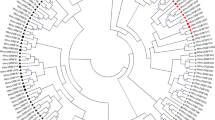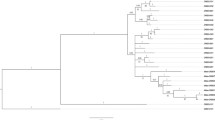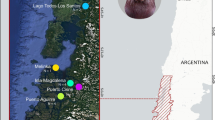Abstract
Habitat fragmentation inhibits gene flow between populations often resulting in a loss of genetic diversity with possible negative effects on fitness parameters. In vertebrates, growing evidence suggests that such genetic diversity is particularly important at the level of the major histocompatibility complex (MHC) because its gene products play an important role in immune functions. Diversity in the MHC is assumed to improve population viability. Here, we investigated the impact of forest fragmentation on the genetic variability of one of the functionally important parts of the MHC, DRB exon 2, of the endemic mouse lemur Microcebus murinus by comparing populations inhabiting two littoral forest fragments of different size in southeastern Madagascar. Twelve different alleles of DRB exon 2 were found in 145 individuals of M. murinus with high levels of sequence divergence between alleles. In both subpopulations, levels of genetic diversity were high, and the genetic analyses revealed only limited effects of fragmentation. Significantly more non-synonymous than synonymous substitutions were found in the functionally important antigen recognition and binding sites indicating selection processes maintaining MHC polymorphism. This is the first study on MHC variation in a free-ranging Malagasy lemur population.
Similar content being viewed by others
References
Antunes SG, Groot NG, Brok H, Doxiadis G, Menezes AAL, Otting N, Bontrop RE (1998) The common marmoset: A new world primate species with limited MHC class II variability. Proc. Nat. Acad. Sci. USA, 95, 11745–11750.
Bergström T, Gyllensten U (1995) Evolution of MHC class II polymorphism: The rise and fall of class II gene function in primates. Immun. Rev., 143, 13–31.
Bontrop RE, Ottig N, de Groot NG, Doxiadis GGM (1999) Major histocompatibility complex class II polymorphisms in primates. Immun. Rev., 167, 339–350.
Brewer BA, Lacy RC, Foster ML, Alaks G (1990) Inbreeding depression in insular and central populations of Peromyscus mice. J. Hered., 81, 257–266.
Brown JH, Jardetzky TS, Saper MA, Samraoui B, Bjorkman PJ, Wiley DC (1988) A hypothetical model of foreign antigen binding site of class II histocompatibility molecules. Nature, 332, 845–850.
Brown JH, Jardetzky TS, Gorga JC, Stern LJ, Urban RG, Strominger JL, Wiley DC (1993) Three-dimensional structure of the human class II histocompatibility antigen HLA-DR1. Nature, 364, 33–39.
Edwards SV, Potts WK (1996) Polymorphism of genes in the major histocompatibility complex (MHC): Implications for conservation genetics. In: Molecular Genetic Approaches in Conservation (eds. Smith TB, Wayne RK), pp. 214–237. Oxford University Press, New York.
FTM (1957 reprinted 1990). Carte de Madagascar. 1: 100.000: Feuille 62. Tolagnaro. Foiben-Taosarintanin’i Madagascar, Antananarivo.
Gade DW (1996) Deforestation and its effects in highland Madagascar. Mountain Res. Develop., 16, 101–116.
Ganzhorn JU, Lowry II PP, Schatz GE, Sommer S (2001) The biodiversity of Madagaskar: One of the world’s hottest hotspots on its way out. Oryx, 35, 1–3.
Ganzhorn JU, Schmid J (1998) Different population dynamics of Microcebus murinus in primary and secondary deciduous dry forests of Madagascar. Int. J. Primatol., 19, 785–796.
Garbutt N (1999) Mammals of Madagascar. Pica Press, East Sussex.
Go Y, Satta Y, Kawamoto Y, Rakotoarisoa G, Randrianjafy A, Koyama N, Hirai H (2002) MHC-DRB genes evolution in lemurs. Immunogenetics, 54, 403–417.
Green GM, Sussman RW (1990) Deforestation history of the eastern rainforest of Madagascar from satellite images. Science, 248, 212–215.
Guo S, Thompson E (1992) Performing the exact test of Hardy-Weinberg proportion for multiple alleles. Biometrics, 48, 361–372.
Gyllensten U, Bergström T, Josefsson A, Sundvall M, Savage A, Blumer ES, Giraldo LH, Soto LH, Watkins DI (1994) The cotton-top tamarin revisited: MHC class I polymorphism of wild tamarins, and polymorphism and allelic diversity of the class II DQA1, DQB1, and DRB loci. Immunogenetics, 40, 167–176.
Hartl DL, Clark AG (1989) Principles of population genetics. Sinauer Associates, Inc., Publishers, Sunderland, Massachusetts.
Hedrick PW (1994) Evolutionary genetics at the major histocompatibility complex. Am. Nat., 143, 945–964.
Hedrick PW, Lee RN, Parker KM (2000) Major histocompatibility complex (MHC) variation in the endangered Mexican wolf and related canids. Heredity, 85, 617–624.
Hedrick PW, Kim TJ, Parker KM (2001a) Parasite resistance and genetic variation in the endangered Gila topminnow. Anim. Conserv., 4, 103–109.
Hedrick PW, Parker KM, Lee RN (2001b) Using microsatellite and MHC variation to identify species, ESUs, and MUs in the endangered Sonoran topminnow. Mol. Ecol., 10, 1399–1412.
Hughes AL, Nei M (1988) Pattern of nucleotide substitution at major histocombatibility complex class I loci reveals over-dominant selection. Nature, 335, 167–170.
Hughes AL, Nei M (1989) Nucleotide substitution at major histocompatibility complex class II loci: Evidence for over-dominant selection. Proc. Nat. Acad. Sci. USA, 86, 948–962.
Hughes AL, Yeager M (1998) Natural selection at major histocompatibility complex loci of vertebrates. Ann. Rev. Genet., 32, 415–434.
Jordan WC, Bruford MW (1998) New perspectives on mate choice and the MHC. Heredity, 81, 127–133.
Jukes TH, Cantor CR (1969) Evolution of protein molecules. In: Mammalian Protein Metabolism (ed. Munro HN), pp. 21–132. Academic Press, New York.
Kumar S, Tamura K, Jakobson IB, Nei M (2001) MEGA2: Molecular Evolutionary Genetics Analysis software, Arizona State University, Tempe Arizona, USA.
Lacy RC (1997) Importance of genetic variation to the viability of mammalian populations. J. Mamm., 78, 320–335.
Lande R (1988) Genetics and demography in biological conservation. Science, 241, 1455–1460.
Lahann, P (2001) Verhaltensflexibilität von Microcebus murinus in Trocken-und Regenwäldern Madagaskars. Diploma thesis, Universität Hamburg, Germany.
Langefors A, Lohm J, Grahn M, Andersen O, von Schantz T (2001) Association between major histocombatibility complex class IIB alleles and resistance to Aeromonas salmonicida in Atlantic salmon. Proc. Roy. Soc. Lond. B, 268, 479–485.
Nei M (1987) Molecular Evolutionary Genetics. Columbia University Press, New York.
Mc Carthy C (1998) CHROMAS. Version 1.45. Griffith University, Southport, Queensland, Australia.
MIR Télédétection Inc (1998) Etude sur la déforestation dans la région de Fort-Dauphin, Madagascar. Rapport final soumis à QIT Madagascar Minerals, Montreal.
Miththapala S, Seidensticker J, O’Brien SJ (1996) Phylogeographic subspecies recognition in leopards (Panthera pardus): Molecular genetic variation. Conserv. Biol., 10, 1115–1132.
Myers N, Mittermeier RA, Mittermeier CG, da Fonseca GAB, Ken J (2000) Biodiversity hotspots for conservation priorities. Nature, 403, 853–858.
Nei M (1987) Molecular Evolutionary Genetics. Columbia University Press, New York.
Nei M, Gojobori T (1986) Simple methods for estimating the number of synonymous and nonsynonymous nucleotid substitutions. Mol. Biol. Evol., 3, 418–426.
Nelson R, Horning N (1993) AVHRR-LAC estimates of forest area in Madagascar, 1990. Intern. J. Rem. Sens., 14, 1463–1475.
Nicholas KB, Nicholas HB (2000) GeneDoc: A Tool for Editing and Annotating multiple Sequence Alignment. Version 2.6. Pittsburgh.
Nino-Vasquez JJ, Vogel D, Rodriguez R, Moreno A, Patarroyo ME, Pluschke G, Daubenberger CA (2000) Sequence and diversity of DRB genes of Aotus nancymaae, a primate model for human malaria parasites. Immunogenetics, 51, 219–230.
Packer C, Pusey AE, Rowley H, Gilbert DA, Martenson J, O’Brien SJ (1991) Case study of a population bottleneck: Lions of the Ngorongoro Crater. Conserv. Biol., 5, 219–230.
Paterson S, Wilson K, Pemberton JM (1998) Major histocompatibility complex variation associated with juvenile survival and parasite resistance in a large unmanaged ungulate population (Ovis aries L.). Evolution, 95, 3714–3719.
Potts WK, Wakeland EK (1993) Evolution of MHC genetic diversity: A tale of incest, pestilence and sexual preference. Trends Genet., 9, 408–412.
Potts WK, Manning CJ, Wakeland EK (1994) The role of infectious disease, inbreeding and mating preferences in maintaining MHC genetic diversity: An experimental test. Phil. Trans. Roy. Soc. Lond. B, 346, 369–378.
Radespiel U, Sarikaya Z, Zimmermann E, Bruford MW (2001) Sociogenetic structure in a free-living nocturnal primate population: Sex-specific differences in the grey mouse lemur (Microcebus murinus). Behav. Ecol. Sociobiol., 50, 493–502.
Ramanamanjato J-B, Ganzhorn JU (2001) Effects of forest fragmentation, introduced Rattus rattus and the role of exotic tree plantations and secondary vegetation for the conservation of an endemic rodent and a small lemur in littoral forests of southeastern Madagascar. Anim. Conserv., 4, 175–183.
Ratsirarson J, Goodman SM (1998) Inventaire biologique de la foret littorale de Tampolo (Fenoarivo Atsinanana). Série Sciences Biologiques, Vol. 14. Centre d’Information et de Documentation Scientifique et Technique. Antananarivo, Madagascar.
Raymond M, Rousset F (1995) An exact test for population differentiation. Evolution, 49, 1280–1283.
Rosal-Sánchez M, Paz-Artal E, Moreno-Pelayo MA, Martinez-Quiles N, Martinez-Laso J, Martin-Villa JM, Arnaiz-Villena A (1998) Polymorphism of MHC-DRB allels in Cercophithecus aethiops (green monkey): Generation and functionality. Tissue Antigens, 51, 541–548.
Schatz GE (2000) Endemism in the Malagasy tree flora. In: Biogeography of Madagascar (eds. Lourenço W, Goodman SM), pp. 1–9. Mémoires de la Société de Biogéographie, Paris.
Schatz GE, Birkinshaw C, Lowry II PP, Randriantfika F, Ratovoson F (2000) The endemic plant families of Madagascar project: Integrating taxonomy and conservation. In: Biogeography of Madagaskar (eds. Lourenço WR, Goodman SM), pp. 11–24. Mémoires de la Société de Biogéographie, Paris.
Schneider S, Roessli D, Excoffier L (2000) ARLEQUIN. A software for Population Genetics Data Analysis. Version 2000, Geneva, Switzerland.
Seddon JM, Baverstock PR (1998) Eight rat RT1.Ba sequences. Immunogenetics, 48, 161–162.
Seddon JM, Baverstock PR (1999) Variation on islands: Major histocombatibility complex (MHC) polymorphism in population of the Australian bush rat. Mol. Ecol., 8, 2071–2079.
Sommer S, Schwab D, Ganzhorn JU (2002) MHC diversity of endemic Malagasy rodents in relation to range contraction and social system. Behav. Ecol. Sociobiol., 51, 214–221.
Sommer S (2003) Effects of habitat fragmentation and changes of dispersal behaviour after a recent population decline on the genetic variability of non-coding and coding DNA of an monogamous Malagasy rodent. Mol. Ecol. (in press).
Van den Bussche RA, Ross TG, Hoofer SR (2002) Genetic variation at a major histocompatibility locus within and among populations of white-tailed deer (Odocoileus virginianus). J. Mamm., 83, 31–39.
Wimmer B, Tautz D, Kappeler PM (2002) The genetic population structure of the gray mouse lemur (Microcebus murinus), a basal primate from Madagascar. Behav. Ecol. Sociobiol., 52, 166–175.
Wright S (1965) The interpretation of population structure by F-statistics with special regard to systems of mating. Evolution, 19, 395–420.
Author information
Authors and Affiliations
Rights and permissions
About this article
Cite this article
Schad, J., Sommer, S. & Ganzhorn, J. MHC Variability of a Small Lemur in the Littoral Forest Fragments of Southeastern Madagascar. Conserv Genet 5, 299–309 (2004). https://doi.org/10.1023/B:COGE.0000031137.50239.d3
Issue Date:
DOI: https://doi.org/10.1023/B:COGE.0000031137.50239.d3




